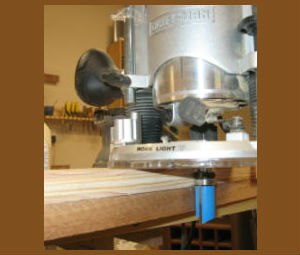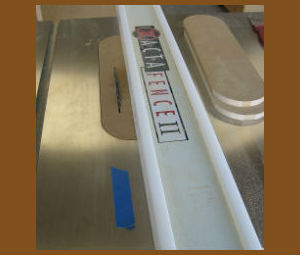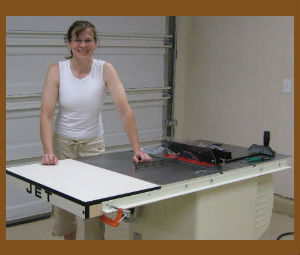 “Cutting a Straight Edge” Use the router with a pattern bit.
“Cutting a Straight Edge” Use the router with a pattern bit.
I don't have a track saw and my table saw sled is only about 24" wide so cutting a straight edge on a glued up solid wood piece wider than 24" can be a real challenge. Even those less than 24" that are very long are difficult to cut straight with the sled. I found the solution in my router. When I wanted to cut a curved piece I would put the pattern bit in the router and trim the rough cut piece to the exact curve with a pattern piece – why not do the same with straight cut using a straight edge as a pattern. I have a jig for my circular saw to make rough cuts when cutting out pieces from a large panel stock, so I used that to rough cut the straight edge. I left it about 1/16" proud of my final dimension. I then secured the straight edge to the end and ran the trim router along the edge for a perfectly straight and square edge.
 "Zero Clearance Insert" creates sharp precision cut.
"Zero Clearance Insert" creates sharp precision cut.
First thing I did was cut six pieces of ½” MDF to the exact width and length of the original throat plate. Then I used the stock throat plate to trace around the MDF pieces and with the band saw I cut about 1/16” proud of the line. I set up my trim router with a flush trim bit (a router table with a pattern bit works great too). I secured the stock plate firmly to my MDF using double stick tape, and I trimmed the insert to the exact size. The test fit was perfect.
 "Buy the Tool and Build the Jig" Buy the right tool for the job and build the jig to make the job easier.
"Buy the Tool and Build the Jig" Buy the right tool for the job and build the jig to make the job easier.
Woodworking provides a wide spectrum of challenges depending on you experience and training. If you are new to woodworking a basic mortise and tenon joint can provide an adequate challenge. If you are an experienced woodworker a free-hand cut inlay might be a good challenge; there are hundreds. For me, while I consider myself a pretty good woodworker, there are many basic woodworking techniques that still provide a challenge; even the perfect fitting tenon is occasionally elusive.